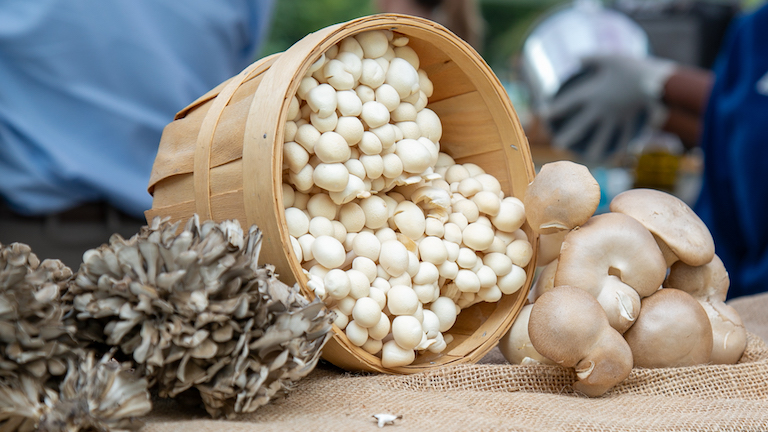 Schools
Schools
Local Produce Continues to Appear on Menus This Fall
Welcome back to a very different opening of our school year. As we move forward feeding the kids, we see local purchases continuing to rise. Some of this is driven by the increased availability of local products, and mushrooms are one of those items.
While mushrooms are available year-round, Fall is an especially special time to focus on mushrooms – their rich, earthy flavors make sauces, stews, and casseroles hearty and filling. They continue to be a great Farm to School item for highlighting local produce in fresh applications too (especially now, during Farm to School Month!); marinated salads, ramen bars, pizza, and grab and go salads are all great places for mushrooms to shine.
We love when we see so many schools add local mushrooms to the meals, and in new innovative ways in this shifting meal service landscape.
That is why it’s such an honor this month to share a little more about how sustainable mushrooms are. Adding mushrooms to school lunch menus not only improves student health, it’s good for the Earth, too (read on to find out why!).
Mighty Mushroom Facts
First, some fun and interesting fact about the mighty mushroom:
- Mushrooms are grown indoors, in beds, with very specific humidity, light, and bedding.
- 7.1 pounds of mushrooms are grown per square foot, achieved in part because mushroom beds are stacked vertically in growing facilities, allowing a high volume of mushrooms to be grown in a relatively small space (more on the magic of mushroom growing space below.
- Mushrooms have a low CO2 emissions and energy footprint. Researchers in 2017 calculated that one pound of mushrooms requires 1.0-kilowatt hours (kWh) energy usage.
- The 1.8 gallons of water required to produce a pound of mushrooms is a fraction of water inputs required for many other foods, especially produce.
Mushrooms’ Small Growing Space Conserves Soil, Nets High Yields
- Each year, growers are able to produce millions of pounds of mushrooms on just a few acres of land.
- In addition, the soil used to produce mushrooms is made of composted materials.
- After mushrooms are harvested, the soil is recycled for multiple uses, including potting soil.
Making the Mushroom Bed
- Because mushrooms have no chlorophyll, they must get all their nutrients from the organic matter in their growing medium, the compost.
- Making mushroom compost involves wetting and mixing organic materials including corn cobs, hay, straw, cottonseed and cocoa seed shells, and nitrogen supplements to initiate aerobic fermentation (composting), which lasts about 7-14 days.
- The compost is then made mushroom-ready by pasteurization and a highly controlled temperature dependent process to remove any ammonia. The bed is now ready to use to help mushrooms grow!
Harvesting
- Mushrooms are harvested by hand throughout a 16 – 35 day cycle. It takes about 15 weeks total to complete a growing cycle.
- After the mushrooms are harvested, the house is emptied and steam-sterilized before the process begins again and the remaining compost is recycled for potting soil.
- The harvested mushrooms are set in carts, refrigerated and then packaged and shipped quickly to supermarkets, food processors and you.
- The entire farm-to-fork process from the time the farmer starts preparing the compost until the mushrooms are harvested and shipped to market takes about four months.
Celebrate Local Mushrooms This #F2SMonth!
As you’re planning your menus, take a moment this month to consider adding fresh mushrooms to your meals. Not only are they packed with immune-boosting vitamins and minerals like selenium and Vitamin D, they’re often grown by farmers not too far from you! Putting mushrooms on the menus means supporting US agriculture, as well as student health.
To help you celebrate local mushrooms this month, be sure to check out our helpful resources (great for year-round support too!)
Farm to School Marketing and Handouts
Food Literacy Lessons for Students
Mushroom Culinary Training Course (Approved for 1 CEU)
Mushroom Fact Sheets and Recipes for Adults and Families


We collect, use and process your data according to our Privacy Policy.